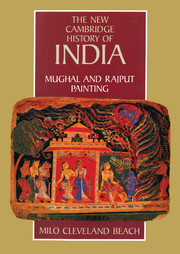Book contents
- Frontmatter
- Introduction
- 1 Painting in North India before 1540
- 2 1540–1580: Painting at Muslim courts
- 3 1580–1600: The new imperial style and its impact
- 4 1600–1660: Mughal painting and the rise of local workshops
- 5 1660–1700: The growth of local styles
- 6 1700–1800: The Dominance of Rajput Painting
- 7 1800–1858: Traditionalism and new influences
- Appendix
- Bibliographical essay
- Index
- The New Cambridge History of India
- Frontmatter
- Introduction
- 1 Painting in North India before 1540
- 2 1540–1580: Painting at Muslim courts
- 3 1580–1600: The new imperial style and its impact
- 4 1600–1660: Mughal painting and the rise of local workshops
- 5 1660–1700: The growth of local styles
- 6 1700–1800: The Dominance of Rajput Painting
- 7 1800–1858: Traditionalism and new influences
- Appendix
- Bibliographical essay
- Index
- The New Cambridge History of India
Summary
If the title Mughal and Rajput Painting suggests a simple historical tradition to be investigated through its year to year development, then it is misleading. The subject is, instead, a rich interweaving of varied and sometimes contradictory interests and traditions.
An initial unity is provided by format, for the earliest paintings to concern us were book illustrations. This means that the works were small (although books can, of course, vary dramatically in size), usually on paper, and closely linked to a literary narrative. The physical arrangement of volumes, however, evolved from two quite distinct sources: the cultural traditions that surrounded Hinduism and Islam. These were the major religious systems in India during the years included in this study, approximately 1500–1850. The earliest Hindu books, and related Buddhist and Jain volumes, were usually on pages made from leaves of the talipot palm; long and horizontal in format, the pages were pierced and threaded onto cords tied between wooden covers. The occasional illustrations were small and usually square. Islamic books, on the other hand, were on paper, bound along a spine, and often encased in leather covers. They were almost exclusively vertical, and were close to left – the reverse of the European system. While paper became plentiful in India after about 1400, so entrenched were traditional attitudes that Hindu artists and craftsmen only slowly took advantage of the freedom that the new material allowed, to vary the size and shape from the severely restricted palm-leaf format. And even then the folios were seldom bound. Kept in stacks, the loose paper pages were wrapped in cloth and tied in bundles.
- Type
- Chapter
- Information
- Mughal and Rajput Painting , pp. 1 - 3Publisher: Cambridge University PressPrint publication year: 1992

